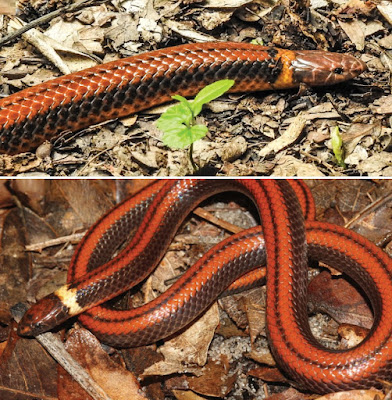 |
| Phalotris shawnella Smith, Brouard & Cacciali,. 2022 DOI: 10.3897/zse.98.61064 |
Abstract
A new species of Phalotris from the nasutus group, Phalotris shawnella sp. nov., is described. It can be distinguished from the other members of the group by having the following combination of characters: 1) fifth supralabial in contact with parietal, 2) vertebral stripe present, 3) yellowish nuchal collar (2 or 3 dorsal scales long), 4) dull reddish color of head, 5) broad, solidly or near solidly dark, lateral bands, 6) red-orange ventral scales lightly and irregularly spotted with black mainly on the posterior half of the body and 7) a bilobed, extremely asymmetrical hemipenis, with enlarged, curved, lateral spines. The species is only known from a recent specimen collected in the Cerrado zone of northeastern Paraguay at Rancho Laguna Blanca, San Pedro department, and two photographic records of live specimens from this and an additional locality. Limited ecological data based on observations of a captive individual, and a wild record, are provided, and a conservation assessment is performed for this extremely limited range Paraguayan endemic snake.
Key Words: endemic, hemipenis, Phalotris nasutus, Phalotris shawnella sp. nov.
Phalotris shawnella sp. nov.
Diagnosis: Phalotris shawnella sp. nov. is assigned to the nasutus group on account of the pointed snout with prominent rostral shield and the fusion of the second and third temporal plates (Fig. 3A). The new species can be distinguished from all other members of the nasutus group by the combination of the following characters: 1) fifth supralabial in contact with parietal, 2) vertebral stripe present, 3) yellowish nuchal collar (2 or 3 dorsal scales long), 4) dull reddish color of head in adults, 5) broad, solidly or near solidly dark lateral bands, 6) red-orange ventral scales lightly and irregularly spotted with black, mainly on the posterior half of the body, and 7) a bilobed, extremely asymmetrical hemipenis, with enlarged, curved, lateral spines.
Etymology: The species name is a combination of the first names of two remarkable young people who were born around the same time as Fundación Para La Tierra, and who inspired its founders to work towards the study and conservation of the Paraguayan fauna, so that one day they might inherit a better world: Shawn Ariel Smith Fernández and Ella Bethany Atkinson. The epithet is not Latin, is invariable (word in apposition) and is made up of elements of both of their names.
Paul Smith, Jean-Paul Brouard and Pier Cacciali. 2022. A New Species of Phalotris (Serpentes, Colubridae, Elapomorphini) from Paraguay. Zoosystematics and Evolution. 98(1): 77-85. DOI: 10.3897/zse.98.61064
Resumen: Se presenta la descripción de una nueva especie de Phalotris del grupo nasutus, Phalotris shawnella sp. nov. puede ser diferenciada de otros miembros del grupo por tener la siguiente combinación de caracteres: 1) quinta supralabial en contacto con la parietal, 2) presencia de una estría vertebral oscura, 3) collar nucal amarillento (de 2 ó 3 escamas de ancho), 4) coloración rojiza en la cabeza, 5) ancha faja lateral muy oscura o bastante oscura, 6) escamas ventrales rojo-anaranjadas e irregularmente salpicadas de negro principalmente en la parte posterior del cuerpo, y 7) hemipenes bilobados, extremadamente asimétricos, con espinas laterales agrandadas y curvas. La especie se la conoce únicamente de un ejemplar colectado en el Cerrado en el noreste de Paraguay en el Rancho Laguna Blanca, departamento de San Pedro, además de dos registros fotográficos de ejemplares vivos, uno de esta misma localidad y otro de una localidad adicional. Se proveen datos ecológicos limitados, en base a observaciones de un ejemplar en cautiverio, y otro en la naturaleza, así como una propuesta de evaluación del estado de conservación para este endemismo de Paraguay de rango extremadamente limitado.
Palabras claves: endémico, hemipene, Phalotris nasutus, Phalotris shawnella sp. nov.



